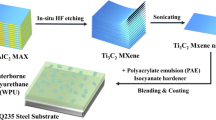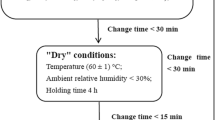Abstract
In this work, AISI 316L stainless steel was coated by nanostructured zirconia using the sucrose assisted sol–gel dip-coating route. Then, the effect of different calcination temperatures and the thickness of the coating on the corrosion protection of 316L stainless steel was investigated. Here, Zr(acac)4 and sucrose were used as starting materials and gelation agents, respectively. Thermogravimetry and differential thermal analysis, X-ray powder diffraction (XRD), Fourier transform infrared, scanning electron microscopy and energy dispersive X-ray spectroscopy were used to characterize the coatings. XRD revealed that the pure tetragonal phase of zirconia was obtained at the calcination temperature of 300–500 °C. However, the mixture of monoclinic (m) and tetragonal (t) phase found in the zirconia coating calcined at 650 °C. Also, by increasing the calcination temperature from 300 to 650 °C, the mean of the crystallite size of structures was increased from 7 to 27 nm. AFM result show that the average roughness value of the sample calcined at 300 °C is 10.5 nm and the dimensions of the particles on the surface of this sample smaller than 50 nm. The potentiodynamic polarization and electrochemical impedance spectroscopy results revealed that the as-synthesized nanostructured sol–gel zirconia coatings exhibited a barrier property for the protection of the substrate. However, the highest corrosion resistance was obtained by the zirconia coating calcined at 300 °C. This was as a result of the desirable compromise of good adhesion, low defect density, and high barrier behaviour. Furthermore, zirconia nanoparticles were synthesized by calcination of the gel at the different temperature. The photocatalytic activity of samples was tested for degradation of methyl orange solutions. It is found that ZrO2 nanoparticles calcined at 500 °C have higher photocatalytic activity than the other samples under UV light.











Similar content being viewed by others
References
M. Finšgar, J. Jackson, Application of corrosion inhibitors for steels in acidic media for the oil and gas industry: a review. Corros. Sci. 86, 17–41 (2014)
X. Chen, P.Y. Hou, C.P. Jacobson, S.J. Visco, L.C. De Jonghe, Protective coating on stainless steel interconnect for SOFCs: oxidation kinetics and electrical properties. Solid State Ion. 176, 425–433 (2005)
M.R. Loghman-Estarki, M. Hajizadeh-Oghaz, H. Edris, R.S. Razavi, Comparative studies on synthesis of nanocrystalline Sc2O3-Y2O3 doped zirconia (SYDZ) and YSZ solid solution via modified and classic Pechini method. CrystEngComm 15, 5898–5909 (2013)
L.B. Chen, Yttria-stabilized zirconia thermal barrier coatings—a review. Surf. Rev. Lett. 13, 535–544 (2006)
A.J. Sánchez-Herencia, C. Pascual, J. He, F.F. Lange, ZrO2/ZrO2 layered composites for crack bifurcation. J. Am. Ceram. Soc. 82, 1512–1518 (1999)
S. Tsunekawa, S. Ito, Y. Kawazoe, J.T. Wang, Critical size of the phase transition from cubic to tetragonal in pure zirconia nanoparticles. Nano Lett. 3, 871–875 (2003)
J. Will, A. Mitterdorfer, C. Kleinlogel, D. Perednis, L.J. Gauckler, Fabrication of thin electrolytes for second-generation solid oxide fuel cells. Solid State Ionics 131, 79–96 (2000)
M.A.D. Crespo, A.G. Murillo, A.M. Torres-Huerta, C. Yañez-Zamora, F.D.J. Carrillo-Romo, Electrochemical behaviour of ceramic yttria stabilized zirconia on carbon steel synthesized via sol–gel process. J. Alloys Compd. 483, 437–441 (2009)
M. Hajizadeh Oghaz, R. Shoja Razavi, M.R. Loghman-Estark, R. Ghasemi, Optimization of morphology and particle size of modified sol gel synthesized YSZ nanopowder using Taguchi method. J. Nano Res. 21, 65–70 (2013)
M. Hajizadeh-Oghaz, R. Shoja Razavi, M. Khajelakzay, Optimizing sol–gel synthesis of magnesia-stabilized zirconia (MSZ) nanoparticles using Taguchi robust design for thermal barrier coatings (TBCs) applications. J. Sol–Gel. Sci. Technol. 73, 227–241 (2014)
H. Ruiz, H. Vesteghem, A.R. Di Giampaolo, J. Lira, Zirconia coatings by spray pyrolysis. Surf. Coat. Technol. 89, 77–81 (1997)
D.E. Ruddell, B.R. Stoner, J.Y. Thompson, The effect of deposition parameters on the properties of yttria-stabilized zirconia thin films. Thin Solid Films 445, 14–19 (2003)
M.F. Al-Kuhaili, S.M.A. Durrani, Effect of annealing on pulsed laser deposited zirconium oxide thin films. J. Alloys Compd. 509, 9536–9541 (2011)
M. Hajizadeh-Oghaz, R. Shoja Razavi, A. Ghasemi, Synthesis and characterization of ceria–yttria co-stabilized zirconia (CYSZ) nanoparticles by sol–gel process for thermal barrier coatings (TBCs) applications. J. Sol–Gel. Sci. Technol. 74, 603–612 (2015)
M. Hajizadeh-Oghaz, R. Shoja Razavi, M.R. Loghman-Estarki, Synthesis and characterization of non-transformable tetragonal YSZ nanopowder by means of Pechini method for thermal barrier coatings (TBCs) applications. J. Sol–Gel. Sci. Technol. 70, 6–13 (2014)
S.K. Tiwari, M. Tripathi, R. Singh, Electrochemical behavior of zirconia based coatings on mild steel prepared by sol–gel method. Corros. Sci. 63, 334–341 (2012)
E. Courtin, P. Boy, C. Rouhet, L. Bianchi, E. Bruneton, N. Poirot, C. Laberty-Robert, C. Sanchez, Optimized sol–gel routes to synthesize yttria-stabilized zirconia thin films as solid electrolytes for solid oxide fuel cells. Chem. Mater. 24, 4540–4548 (2012)
M. Hajizadeh-Oghaz, R.S. Razavi, A. Ghasemi, The effect of solution pH value on the morphology of ceria–yttria co stabilized zirconia particles prepared using the polymerizable complex method. J. Clust. Sci. 27, 469–483 (2016)
E. McCafferty, Validation of corrosion rates measured by the Tafel extrapolation method. Corros. Sci. 47, 3202–3215 (2005)
A. Majedi, F. Davar, A. Abbasi, Sucrose-mediated sol–gel synthesis of nanosized pure and S-doped zirconia and its catalytic activity for the synthesis of acetyl salicylic acid. J. Ind. Eng. Chem. 20, 4215–4223 (2014)
A. Majedi, A. Abbasi, F. Davar, Green synthesis of zirconia nanoparticles using the modified Pechini method and characterization of its optical and electrical properties. J. Sol–Gel Sci. Technol. 77, 542–552 (2016)
R.R. Muthuchudarkodi, C. Vedhi, Preparation and electrochemical characterization of manganese dioxide-zirconia nanorods. Appl. Nanosci. 5, 481–491 (2015)
M. Daturi, C. Binet, S. Bernal, J.A. Perez Omil, J.C. Lavalley, FTIR study of defects produced in ZrO2 samples by thermal treatment residual species into cavities and surface defects. J. Chem. Soc. Faraday Trans. 94, 1143–1147 (1998)
A. Díaz-Parralejo, A. Macías-García, J. Sánchez-González, M.Á. Díaz-Díez, E.M. Cuerda-Correa, A novel strategy for the preparation of yttria-stabilized zirconia powders: deposition and scratching of thin films obtained by the sol–gel method. J. Non-Cryst. Solids 357, 1090–1095 (2011)
S. Chen, Feature selection for identification and classification of power quality disturbances. In Power Engineering Society General Meeting, 2005, vol. 2303. (IEEE, 2005) pp. 2301–2306
M. Lebrini, F. Robert, H. Vezin, C. Roos, Electrochemical and quantum chemical studies of some indole derivatives as corrosion inhibitors for C38 steel in molar hydrochloric acid. Corros. Sci. 52, 3367–3376 (2010)
M. Ates, Review study of electrochemical impedance spectroscopy and equivalent electrical circuits of conducting polymers on carbon surfaces. Prog. Org. Coat. 71, 1–10 (2011)
S. Amand, M. Musiani, M.E. Orazem, N. Pébère, B. Tribollet, V. Vivier, Constant-phase-element behavior caused by inhomogeneous water uptake in anti-corrosion coatings. Electrochim. Acta 87, 693–700 (2013)
N. Soltani, M. Behpour, E.E. Oguzie, M. Mahluji, M.A. Ghasemzadeh, Pyrimidine-2-thione derivatives as corrosion inhibitors for mild steel in acidic environments. RSC Advances 5, 11145–11162 (2015)
A. Di Paola, E. García-López, G. Marcì, L. Palmisano, A survey of photocatalytic materials for environmental remediation. J. Hazard. Mater. 211–212, 3–29 (2012)
X. Qu, P.J.J. Alvarez, Q. Li, Applications of nanotechnology in water and wastewater treatment. Water Res. 47, 3931–3946 (2013)
Z. Shu, X. Jiao, D. Chen, Synthesis and photocatalytic properties of flower-like zirconia nanostructures. CrystEngComm 14, 1122–1127 (2012)
G.N. Shao, S.M. Imran, S.J. Jeon, M. Engole, N. Abbas, M. Salman Haider, S.J. Kang, H.T. Kim, Sol–gel synthesis of photoactive zirconia–titania from metal salts and investigation of their photocatalytic properties in the photodegradation of methylene blue. Powder Technol. 258, 99–109 (2014)
Acknowledgments
The author should have high thanks from Iran National Science Foundation, (INSF, Grant Number 94015036) from financial support of this research.
Author information
Authors and Affiliations
Corresponding authors
Rights and permissions
About this article
Cite this article
Majedi, A., Davar, F., Abbasi, A. et al. Modified Sol–Gel Based Nanostructured Zirconia Thin Film: Preparation, Characterization, Photocatalyst and Corrosion Behavior. J Inorg Organomet Polym 26, 932–942 (2016). https://doi.org/10.1007/s10904-016-0394-7
Received:
Accepted:
Published:
Issue Date:
DOI: https://doi.org/10.1007/s10904-016-0394-7




